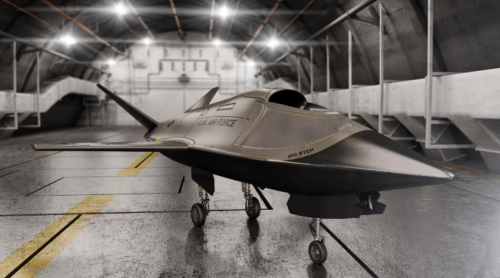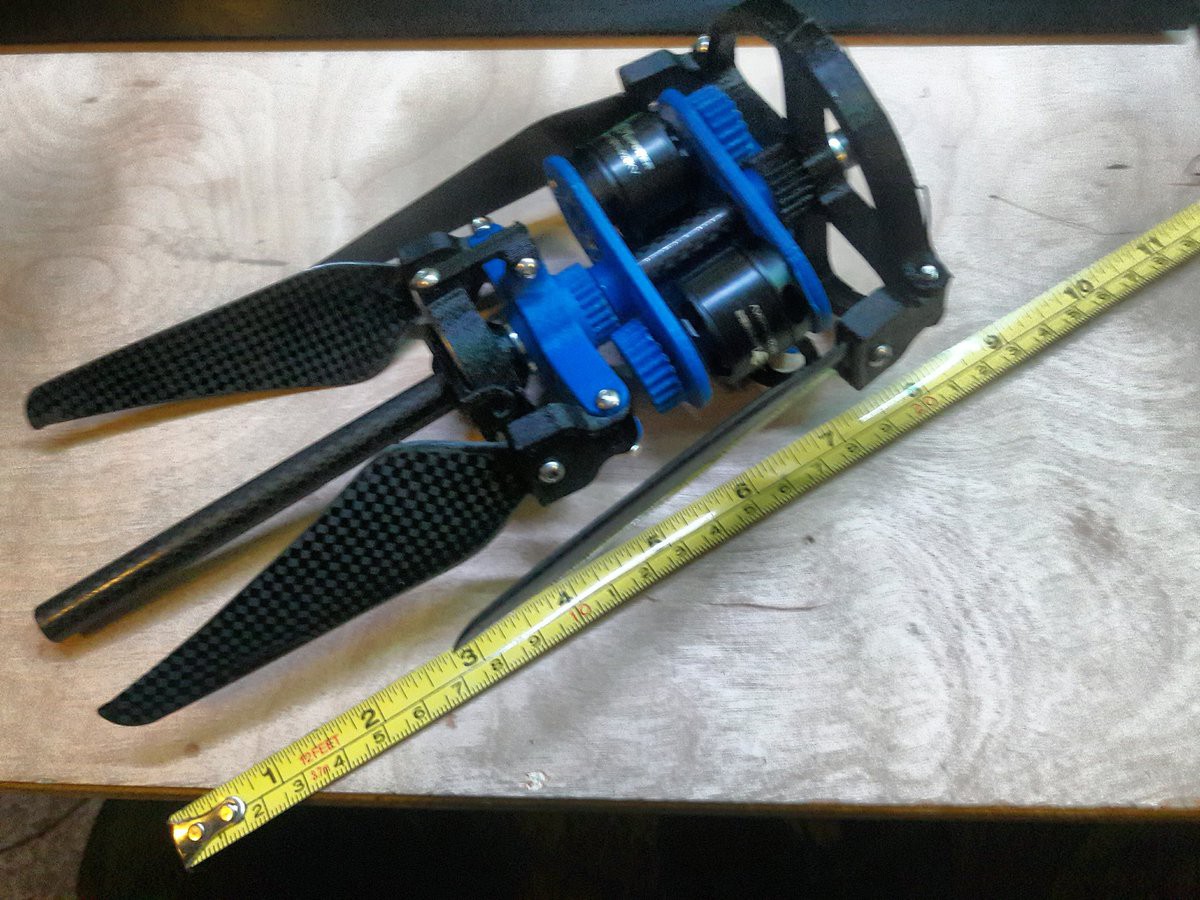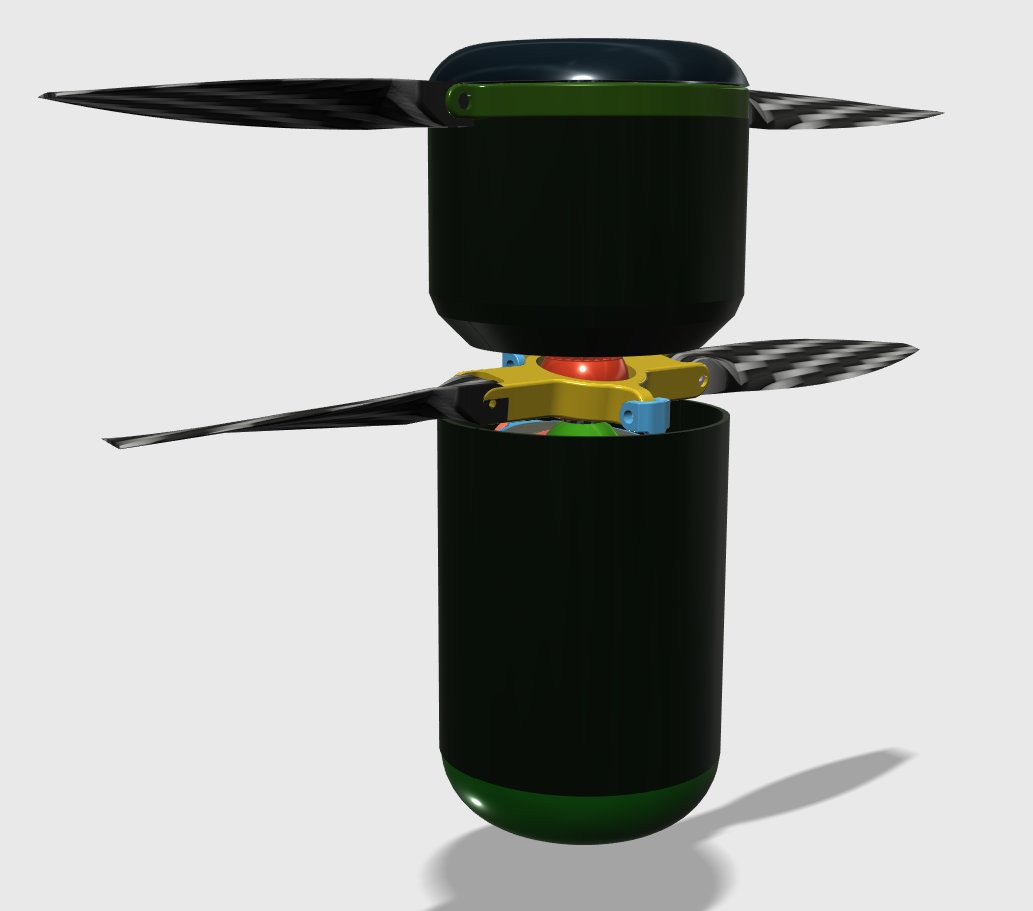Ei nyt ihan minulle aukea miksei tuota voisi tehdä dronella jossa kyydissä laserskannauslaite? Käsittääkseni silläkin saa 3D-kuvan kalliosta?Mekanisoitua kartoittamista.
Install the app
How to install the app on iOS
Follow along with the video below to see how to install our site as a web app on your home screen.
Note: This feature may not be available in some browsers.
You are using an out of date browser. It may not display this or other websites correctly.
You should upgrade or use an alternative browser.
You should upgrade or use an alternative browser.
UAV / UCAV / LAR (robotit) Uutiset ja jutut
- Viestiketjun aloittaja Raveni
- Aloitus PVM
Ei nyt ihan minulle aukea miksei tuota voisi tehdä dronella jossa kyydissä laserskannauslaite? Käsittääkseni silläkin saa 3D-kuvan kalliosta?
Heillä oli selvästikin tarkoitus mallintaa maasto jokaista kallion koloa myöten, joten silloin ainoa vaihtoehto on tehdä se maassa. Toisekseen sensori jota käytettiin oli kookas joten lennokki ei olisi senkään puolesta mahdollinen.
Ei nyt ihan minulle aukea miksei tuota voisi tehdä dronella jossa kyydissä laserskannauslaite? Käsittääkseni silläkin saa 3D-kuvan kalliosta?
Puskan alle vaikea mennä lentämällä.
DARPA created the Service Academies Swarm Challenge to help make effective unmanned aerial vehicle (UAV) swarm tactics a reality. The Challenge is a collaboration between the Agency and the three U.S. military Service academies—the U.S. Military Academy, the U.S. Naval Academy, and the U.S. Air Force Academy. An experiment at its heart, the research effort is designed to encourage students to develop innovative offensive and defensive tactics for swarms of small UAVs.
The Service Academies Swarm Challenge is the most recent example of how DARPA works to ensure the technological superiority of U.S. military forces by periodically engaging the U.S. military Service academies in research-oriented competitions.
A fourth-year capstone design course, the Swarm Challenge has pushed students to achieve “zero to swarm in eight months.” The goal: help the academies go from having little swarm-related expertise to developing capabilities with potentially near-term applicability for operational training and fielding—all within one academic year.
http://www.darpa.mil/news-events/2017-04-23
DARPA's Service Academies Swarm Challenge is an aerial game of Capture the Flag played by swarms of unmanned aerial vehicles overseen by human operators. The competition, being waged by students from the three U.S. military Service academies, is an opportunity for the next generation of operators and tacticians to explore and understand swarm-versus-swarm interactions.
Two teams at a time play inside the Battle Cube, a cubic airspace 500 meters on a side, 78 meters above the ground. Each team has been given 20 fixed-wing UAVs and 20 quad-rotor UAVs and, under the rules of play, can field a mixed fleet of up to 25 UAVs for each of two 30-minute battle rounds. Each team protects its “flag” (a large, inflatable ground target) while trying to score the most points before time runs out.
While people often think about swarms as simply being large collections of robots, swarms in fact have five defining characteristics: number, agent complexity, collective complexity, heterogeneity, and human-swarm interaction. The Service Academies Swarm Challenge is designed to explore these characteristics as they apply to both offensive and defensive swarm tactics, and to harness and leverage them for warfighter benefit.
Operationalizing swarm-related capabilities poses many significant challenges, from technology (e.g., battery size and life, user interfaces) to logistics (e.g., transport, upkeep) to understanding the limitations of what swarms can do. The Swarm Challenge provides an experimental testbed that manages these challenges so the academy students can focus on creating innovative swarm tactics.
http://www.darpa.mil/news-events/2017-04-23

Linkin alla video.
http://www.foxnews.com/tech/2017/04...ts-and-hypersubs-to-storm-future-beaches.htmlThe U.S. Marines could deploy a host of futuristic military technology to "storm the beaches."
Included in the new technology are machine-gun toting robots that charge up the beaches as advance assault, as well as speedboats that instantly transformed into small stealthy submarines diving beneath the surface to avoid detection.
For the past two weeks, the Navy and Marine Corps have been quietly testing about 50 new fascinating technologies out at Camp Pendleton, at the Ship-to-Shore Maneuver Exploration and Experimentation Advanced Naval Technology Exercise 2017, in California.
The exercise is investigating how the military can leverage the latest technological advances for ship-to-the-shore, or the space between the Naval ship and the beach where they could potentially land.
Sailors and Marines have been experimenting with the technology and evaluating the wide range of sea, air and land innovations in a variety of realistic scenarios.
The tech includes amphibious vehicles, but also drones like quadcopters and potentially weapon-wielding ground robots.
Designed by General Dynamics, Multi-Utility Tactical Transports (MUTTs) are smart, ATV-sized robots mounted with machine guns that can charge up a beach and drive themselves, while helping dismount small units.
Surf, sand and steep inclines are not going to stop the water-friendly MUTTs. The vehicles drive on tracks, or wheels, and there are two wheeled variants: 8x8 and 6x6.
The robot can be mounted with a range of different weapons, including machine guns.
Kiinalaisten mukaan yllä oleva UAV on "CH-X" nimellä kulkeva maaefekti torpedo.
https://fi.wikipedia.org/wiki/Maaefektialus
1 tunti ja 50 minuuttia lentoaikaa.
1 tonnin räjähdelataus.
Lentokorkeus 1-6 metriä.
https://fi.wikipedia.org/wiki/Maaefektialus
1 tunti ja 50 minuuttia lentoaikaa.
1 tonnin räjähdelataus.
Lentokorkeus 1-6 metriä.
http://www.theregister.co.uk/2017/05/03/us_navy_drone_control_software/The US Navy has tested a software package that will allow aircraft carriers running it to use its planned drone air-to-air tankers for communications relay and surveillance duties.
The MD-5 Unmanned Carrier Aviation Mission Control System (UMCS) was tested under lab conditions using a lorry in place of the drone, according to US website Defence Systems.
In software terms UMCS is not a big leap: USN developers plugged existing mission management, planning and sensor control software into the US Navy's Common Control System framework, tailoring each element as required to talk to the "drone" systems being used.
"We have had the opportunity to leverage many existing technologies and capabilities from other Navy platforms and integrate them into this," said USN Captain Beau Duarte, in command of the USN's Unmanned Carrier Aviation programme.
Testing evaluated UMCS's ability to have multiple signals transmitted from a single source, as well as voice trunking, data sharing capacity and data dissemination. UMCS will also support maritime Automatic Identification System signal detection, allowing it to notice nearby civilian ships broadcasting their presence.
This suggests that the USN is looking at drones as relays: that is, a means of extending its communication and surveillance systems' range. Link 16-compatible aircraft can already exchange tactical data within the range of the aircraft's own systems, so an airborne relay station has obvious potential for extending the range of distributed surveillance from, say, an aircraft carrier's own fighters.
UMCS will eventually be used in American service with the MQ-25 Stingray aerial refuelling drone. Originally conceived as an all-singing, all-dancing unmanned alternative to traditional naval aircraft, the MQ-25 will now mainly be used for topping up the tanks of manned aircraft – and, it seems, some air and sea surveillance work. The drone is specifically being developed to be resistant to hackers, according to the USN.
http://spectrum.ieee.org/automaton/robotics/industrial-robots/demo-sarcos-snake-robotLast week, a visitor slithered through the IEEE Spectrum office.
The robotics company Sarcos had brought around its new snake robot, the Guardian S, to show off its moves. While it performed its tricks—shimmying sideways, rolling over, rearing up, and even sliding its magnetized body straight up a metal door—an impressed staff member mentioned that his son would love to have a snakebot to play with. “We’re taking orders if you want one!” said Sarcos CEO Ben Wolff. “Only $60,000.”
Of course, the Guardian S isn’t meant to be a pet or a plaything; the applications Wolff rattles off are in the realms of industry and security. As an agile surveillance agent, the snakebot could conduct inspections in confined spaces or in hazmat conditions, help with search and rescue after a disaster, or assist bomb squads and SWAT teams.
Mekaanisen velociraptorin prototyyppi. Ainoastaan selkäranka ja häntä puuttuvat.
The Planar Elliptical Runner is a running robot that can run about 12 miles per hour on a treadmill. It is sandwhiched between two plates of glass, which keep it in the sagittal plane. It cannot turn or tip sideways, but it can tip forward/backward and fall down. The robot is "open loop stable". There is only 1 motor driving the legs. There are no sensors or computers on board. An RC car radio controller determines how much power to apply to the motor. Give the robot more power and it runs faster. Less power and it runs slower.
Viimeksi muokattu:
https://arxiv.org/pdf/1704.05588.pdf
http://spectrum.ieee.org/automaton/...uses-ai-and-11500-crashes-to-learn-how-to-flyOne way to think of flying (or driving or walking or any other form of motion) is that success is simply a continual failure to crash. From this perspective, the most effective way of learning how to fly is by getting a lot of experience crashing so that you know exactly what to avoid, and once you can reliably avoid crashing, you by definition know how to fly. Simple, right? We tend not to learn this way, however, because crashing has consequences that are usually quite bad for both robots and people.
The CMU roboticists wanted to see if there are any benefits to using the crash approach instead of the not crash approach, so they sucked it up and let an AR Drone 2.0 loose in 20 different indoor environments, racking up 11,500 collisions over the course of 40 hours of flying time. As the researchers point out, “since the hulls of the drone are cheap and easy to replace, the cost of catastrophic failure is negligible.” Each collision is random, with the drone starting at a random location in the space and then flying slowly forward until it runs into something. After it does, it goes back to its starting point, and chooses a new direction. Assuming it survives, of course.
How well does this work? It’s usually not as good as a human pilot, except in relatively complex environments, like narrow hallways or hallways with chairs. But compared to a baseline approach using monocular depth estimation, it’s massively better, somewhere between 2x and 10x the performance (in both time in the air and distance flown), depending on the environment. The biggest benefit comes from navigating around featureless walls and glass doors, both of which are notoriously challenging for depth estimation.
The obvious question to ask is whether this method is actually more effective than the alternative, which is teaching a drone to fly through not crashing instead. I’m not sure what the answer is, but the point is that if you allow crashing, the entire learning process can be self-supervised: Just set the drone up in a room and let it do its thing. You’ll have to change the batteries (and the hull, on occasion) but otherwise all of the data collection and learning is completely autonomous. If, on the other hand, you try to teach a drone to fly through not crashing, you have to find a way to make sure that it doesn’t crash. You can do that by learning from a human pilot, or putting it in some environment with a motion capture system and some 3D maps of obstacles and whatnot, but that adds cost and complexity. Crashing is so much easier

http://www.draganfly.com/products/draganscout/overviewThe DraganScout by Draganfly Innovations Inc. is a unique ground-based robot with the ability to morph and adapt to different application or mission needs. The ability to climb stairs, stand vertically, extend a payload to 72", and tackle the worst terrain. In 1998, Draganfly Innovations re-invented the helicopter, and in 2017, re-invented the wheel. The patented wheel technology allows the wheel to quickly morph from a fast-running round shape to a claw shape for tackling stairs or other obstacles. The boom is also used as a powerful tail to assist in climbing stairs or to maintain balance while standing.
http://www.defenseone.com/technolog...-Drones-to-Fight-ISIS/137987/?oref=d-topstoryTAMPA, Florida — Here’s how Mad Max the situation in Iraq is right now. Earlier this year, the military put out an urgent request for inexpensive kamikaze drones that special operations troops could fire from handheld bazooka-like launchers against ISIS, according to documents obtained by Defense One. It’s another sign that drone warfare is changing far faster than traditional military equipping can keep up, a fact reinforced this week by leaders with U.S. Special Operations Command, or SOCOM.
In its Joint Urgent Operational Needs Statement, SOCOM requested 325 “Miniature Aerial Missile Systems,” or LMAMS, by summer. That delivery has already been completed. AeroVironment officials confirmed to Defense One that they recently delivered about 350 Switchblades, a tube-launched drones outfitted with cameras and cursor-on-target GPS navigation. The company bills the device as a “miniature flying lethal missile can be operated manually or autonomously.” It can fly for about 15 minutes, at up to 100 miles per hour. The Pentagon put a similar request for Switchblades back in 2013.
Special operations forces have highlighted the need for new types of drones, or drone missiles, to strike rapidly adapting non-state enemies like the Islamic State. To help drive innovation, U.S. Special Operations Command intends to open a hacker lab in Tampa as part of the broader SOFWERX initiative.

http://www.kratosusd.com/capabilities/unmanned-tactical-systems/xq-222Representing a clean-sheet, low-cost UAS solution, the XQ-222 is changing the paradigm for tactical UAS technology. The XQ-222 delivers a combination of long-range, high-speed, and maneuverability, along with the capability of delivering a mix of lethal weapons from its internal bomb bay and wing stations.
Equally adept in the role of Strike or Air-to-Air UAS, the XQ-222 is the future for manned/unmanned teaming and is the affordable alternative for ISR, Strike, Air-to-Air or EA missions. Runway-independence and extreme range deliver maximum operational flexibility and utility to the Warfighter.
https://www.defense.gov/Portals/1/D...Exhibit_Information_Kit_FINAL_16_May_2017.pdf
Kohta puoleen tämmöiset ovat jokaisen ydinsukellusveneen peruskalustoa.
Lockheed Martin successfully launches Vector Hawk, a small, unmanned aerial vehicle (UAV), on command from the Marlin MK2 autonomous underwater vehicle (AUV) during a cross-domain command and control event hosted by the U.S. Navy. In addition to Marlin and Vector Hawk, the Submaran, an unmanned surface vehicle (USV) developed by Ocean Aero, provided surface reconnaissance and surveillance. This effort marks a milestone in showing that an unmanned aircraft, surface vessel and undersea vehicle can communicate and complete a mission cooperatively and completely autonomously
https://www.cnet.com/news/dubai-deploys-first-robotic-police-officer/Though it's not quite Paul Verhoeven's satirical vision of robotic police, Dubai's first Robocop has started its duties as part of a new police program.
The Robocop is a customised service robot from Pal Robotics that will be posted in malls and tourist attractions, and people can use the touchscreen embedded in its chest to report crime, pay fines and get information.
"Now most people visit police stations or customer service, but with this tool we can reach the public 24/7 and it won't ask for any sick leave or maternity leave," Brig Khalid Al Razooqi, Dubai Police director general of smart services, said in a statement.
The robot has built-in cameras that will stream video back to the police command centre. The next batch will be used to tackle crimes, and the police force has plans for a 3-metre tall robot piloted by a police officer from the inside for travel up to 80 kilometres per hour and carrying heavy equipment.
According to Al Razooqi, the Dubai police plan to add robots until they reach around 25 percent of the force by 2030, allowing the human members of the police to focus their attention on other areas.



